Brick Debris Dust as an Ecological Filler and Its Effect on the Durability of Asphalt Mix
Abstract
:1. Introduction
- (1)
- fills the void spaces between mineral mix grains;
- (2)
- stiffens the asphalt forming the mineral filled asphalt together with the binder which binds the aggregate mix grains;
- (3)
- improves water tightness and frost resistance of an asphalt mix.
2. Experimental Materials
3. Research Method
3.1. Characterization of Lime Filler and Brick Debris Dust
3.2. Methodology of the Asphalt Mix Tests
- ITSR—indirect tensile strength ratio [%]
- ITSw—the average indirect tensile strength for the wet samples [kPa]
- ITSd—the average indirect tensile strength for the dry samples [kPa]
- The study of the stiffness modulus was performed according to the EN 12697-26:2012 standard.
4. Results and Discussion
4.1. Characteristics of Brick Debris Dust and Lime Filler
4.1.1. Chemical Composition
4.1.2. Mineral Composition
4.1.3. Scanning Electron Microscopy (SEM)
4.1.4. Grading
4.2. Properties of Asphalt Mix
4.2.1. Effect of Brick Debris Dust Addition on Volumetric Properties of Asphalt Mix
4.2.2. Effect of Brick Debris Dust Addition on Water and Frost Resistance and Indirect Tensile Strength of Asphalt Mixtures
4.2.3. Effect of Brick Debris Dust Addition on Stiffness Modulus of Asphalt Mixtures
4.3. Statistical Data Analysis
5. Conclusions
Author Contributions
Funding
Conflicts of Interest
References
- European Asphalt Pavement Association. Asphalt in Figures; EAPA: Brussels, Belgium, 2017. [Google Scholar]
- Farooq, M.A.; Mir, M.S. Use of reclaimed asphalt pavement (RAP) in warm mix asphalt (WMA) pavements: A review. Innov. Infrastruct. Solut. 2017, 2, 1–9. [Google Scholar] [CrossRef] [Green Version]
- Iwański, M.; Chomicz-Kowalska, A.; Maciejewski, K. Application of synthetic wax for improvement of foamed bitumen parameters. Constr. Build. Mater. 2015, 83, 62–69. [Google Scholar] [CrossRef] [Green Version]
- Woszuk, A. Application of fly ash derived zeolites in warm-mix asphalt technology. Materials 2018, 11, 1542. [Google Scholar] [CrossRef] [PubMed] [Green Version]
- Sanchez-Alonso, E.; Vega-Zamanillo, A.; Calzada-Perez, M.A.; Castro-Fresno, D. Mechanical behavior of asphalt mixtures containing silica gels as warm additives. Mater. Struct. Constr. 2018, 51, 1–11. [Google Scholar] [CrossRef]
- Andrzejuk, W.; Barnat-Hunek, D.; Siddique, R.; Zegardlo, B.; Lagód, G. Application of recycled ceramic aggregates for the production of Mineral-Asphalt Mixtures. Materials 2018, 11, 658. [Google Scholar] [CrossRef] [Green Version]
- Raposeiras, A.C.; Movilla-Quesada, D.; Bilbao-Novoa, R.; Cifuentes, C.; Ferrer-Norambuena, G.; Castro-Fresno, D. The use of copper slags as an aggregate replacement in asphalt mixes with RAP: Physical–chemical and mechanical behavioural analysis. Constr. Build. Mater. 2018, 190, 427–438. [Google Scholar] [CrossRef]
- Zofka, A.; Yut, I. Investigation of Rheology and Aging Properties of Asphalt Binder Modified with Waste Coffee Grounds. In Transportation Research E-Circular; Transportation Research Board: Washington, DC, USA, 2012; pp. 61–72. [Google Scholar]
- Woszuk, A.; Wróbel, M.; Franus, W. Influence of waste engine oil addition on the properties of zeolite-foamed asphalt. Materials 2019, 12, 2265. [Google Scholar] [CrossRef] [Green Version]
- Jitsanigam, P.; Biswas, W.K.; Compton, M. Sustainable utilization of lime kiln dust as active filler in hot mix asphalt with moisture damage resistance. Sustain. Mater. Technol. 2018, 17, e00071. [Google Scholar] [CrossRef]
- Simone, A.; Mazzotta, F.; Eskandarsefat, S.; Sangiorgi, C.; Vignali, V.; Lantieri, C.; Dondi, G. Experimental application of waste glass powder filler in recycled dense-graded asphalt mixtures. Road Mater. Pavement Des. 2019, 20, 592–607. [Google Scholar] [CrossRef] [Green Version]
- Woszuk, A.; Bandura, L.; Franus, W. Fly ash as low cost and environmentally friendly filler and its effect on the properties of mix asphalt. J. Clean. Prod. 2019, 235, 493–502. [Google Scholar] [CrossRef]
- Movilla-Quesada, D.; Muñoz, O.; Raposeiras, A.C.; Castro-Fresno, D. Thermal suspectability analysis of the reuse of fly ash from cellulose industry as contribution filler in bituminous mixtures. Constr. Build. Mater. 2018, 160, 268–277. [Google Scholar] [CrossRef] [Green Version]
- Movilla-Quesada, D.; Raposeiras, A.C.; Castro-Fresno, D.; Peña-Mansilla, D. Experimental study on stiffness development of asphalt mixture containing cement and Ca(OH)2 as contribution filler. Mater. Des. 2015, 74, 157–163. [Google Scholar] [CrossRef]
- Nciri, N.; Shin, T.; Lee, H.; Cho, N. Potential of waste oyster shells as a novel biofiller for hot-mix asphalt. Appl. Sci. 2018, 8, 415. [Google Scholar] [CrossRef] [Green Version]
- Dulaimi, A.; Shanbara, H.K.; Jafer, H.; Sadique, M. An evaluation of the performance of hot mix asphalt containing calcium carbide residue as a filler. Constr. Build. Mater. 2020, 261, 119918. [Google Scholar] [CrossRef]
- Choudhary, J.; Kumar, B.; Gupta, A. Utilization of solid waste materials as alternative fillers in asphalt mixes: A review. Constr. Build. Mater. 2020, 234, 117271. [Google Scholar] [CrossRef]
- Hou, Y.; Ji, X.; Zou, L.; Liu, S.; Su, X. Performance of cement-stabilised crushed brick aggregates in asphalt pavement base and subbase applications. Road Mater. Pavement Des. 2015, 17, 120–135. [Google Scholar] [CrossRef]
- Padmini, A.K.; Ramamurthy, K.; Mathews, M.S. Behaviour of concrete with low-strength bricks as lightweight coarse aggregate. Mag. Concr. Res. 2001, 53, 367–375. [Google Scholar] [CrossRef]
- Kibriya, T.; Speare, P.R.S. The use of crushed brick coarse aggregates in concrete. In Proceedings of the International Congress on Concrete in the Service of Mankind, Dundee, Scotland, 24–28 June 1996; pp. 24–28. [Google Scholar]
- Poon, C.S.; Chan, D. Paving blocks made with recycled concrete aggregate and crushed clay brick. Constr. Build. Mater. 2006, 20, 569–577. [Google Scholar] [CrossRef]
- Poon, C.S.; Kou, S.C.; Lam, L. Use of recycled aggregates in molded concrete bricks and blocks. Constr. Build. Mater. 2002, 16, 281–289. [Google Scholar] [CrossRef]
- Poon, C.S.; Chan, D. Feasible use of recycled concrete aggregates and crushed clay brick as unbound road sub-base. Constr. Build. Mater. 2006, 20, 578–585. [Google Scholar] [CrossRef]
- Sun, Y.; Wu, S.; Zhu, J.; Zhong, J. Investigation on static shear creep behavior of asphalt mastic containing recycled red brick powder. In Advanced Materials Research; Trans Tech Publications Ltd.: Stafa-Zurich, Switzerland, 2011; Volume 306–307, pp. 1707–1711. [Google Scholar]
- Wu, S.; Zhu, J.; Zhong, J.; Wang, D. Experimental investigation on related properties of asphalt mastic containing recycled red brick powder. Constr. Build. Mater. 2011, 25, 2883–2887. [Google Scholar] [CrossRef]
- Chen, M.Z.; Lin, J.T.; Wu, S.P.; Liu, C.H. Utilization of recycled brick powder as alternative filler in asphalt mixture. Constr. Build. Mater. 2011, 25, 1532–1536. [Google Scholar] [CrossRef]
- Joohari, M.I.; Aziz, N.A.; Daud, N.M.; Mansor, S.; Abdul Halim, M.A. Performance of porous asphalt pavement using clay brick dust as mineral filler. In Proceedings of the Journal of Physics: Conference Series, Penang Island, Malaysia, 5–6 August 2019; Institute of Physics Publishing: Bristol, UK, 2019; Volume 1349. [Google Scholar]
- Pasandín, A.R.; Pérez, I. The influence of the mineral filler on the adhesion between aggregates and bitumen. Int. J. Adhes. Adhes. 2015, 58, 53–58. [Google Scholar] [CrossRef] [Green Version]
- Lesueur, D.; Teixeira, A.; Lázaro, M.M.; Andaluz, D.; Ruiz, A. A simple test method in order to assess the effect of mineral fillers on bitumen ageing. Constr. Build. Mater. 2016, 117, 182–189. [Google Scholar] [CrossRef]
- Asphalt Surfaces on National Roads, Technical Requirements WT-2 Part I; General Directorate for National Roads and Motorways: Warsaw, Poland, 2014.
- Wróbel, M.; Woszuk, A.; Franus, W. Laboratory Methods for Assessing the Influence of Improper Asphalt Mix Compaction on Its Performance. Materials 2020, 13, 2476. [Google Scholar] [CrossRef] [PubMed]
- Melotti, R.; Santagata, E.; Bassani, M.; Salvo, M.; Rizzo, S. A preliminary investigation into the physical and chemical properties of biomass ashes used as aggregate fillers for bituminous mixtures. Waste Manag. 2013, 33, 1906–1917. [Google Scholar] [CrossRef]
- Zulkati, A.; Diew, W.Y.; Delai, D.S. Effects of fillers on properties of asphalt-concrete mixture. J. Transp. Eng. 2012, 138, 902–910. [Google Scholar] [CrossRef]
- Diab, A.; Enieb, M. Investigating influence of mineral filler at asphalt mixture and mastic scales. Int. J. Pavement Res. Technol. 2018, 11, 213–224. [Google Scholar] [CrossRef]
- Halle, M.; Rukavina, T.; Domitrovic, J. Influence of Temperature on Asphalt Stiffness Modulus. In Proceedings of the 5th Eurasphalt Eurobitume Congress, Istanbul, Turkey, 13–15 June 2012; pp. 13–15. [Google Scholar]
- Ahmed, K.; Irfan, M.; Ahmed, S.; Khattak, A.A.A. Experimental investigation of strength and stiffness characteristics of hot mix asphalt (HMA). Procedia Eng. 2014, 77, 155–160. [Google Scholar] [CrossRef] [Green Version]
- Gandhi, T.; Rogers, W.; Amirkhanian, S. Laboratory evaluation of warm mix asphalt ageing characteristics. Int. J. Pavement Eng. 2010, 11, 133–142. [Google Scholar] [CrossRef]
- Woszuk, A.; Franus, W. Properties of the Warm Mix Asphalt involving clinoptilolite and Na-P1 zeolite additives. Constr. Build. Mater. 2016, 114, 556–563. [Google Scholar] [CrossRef]
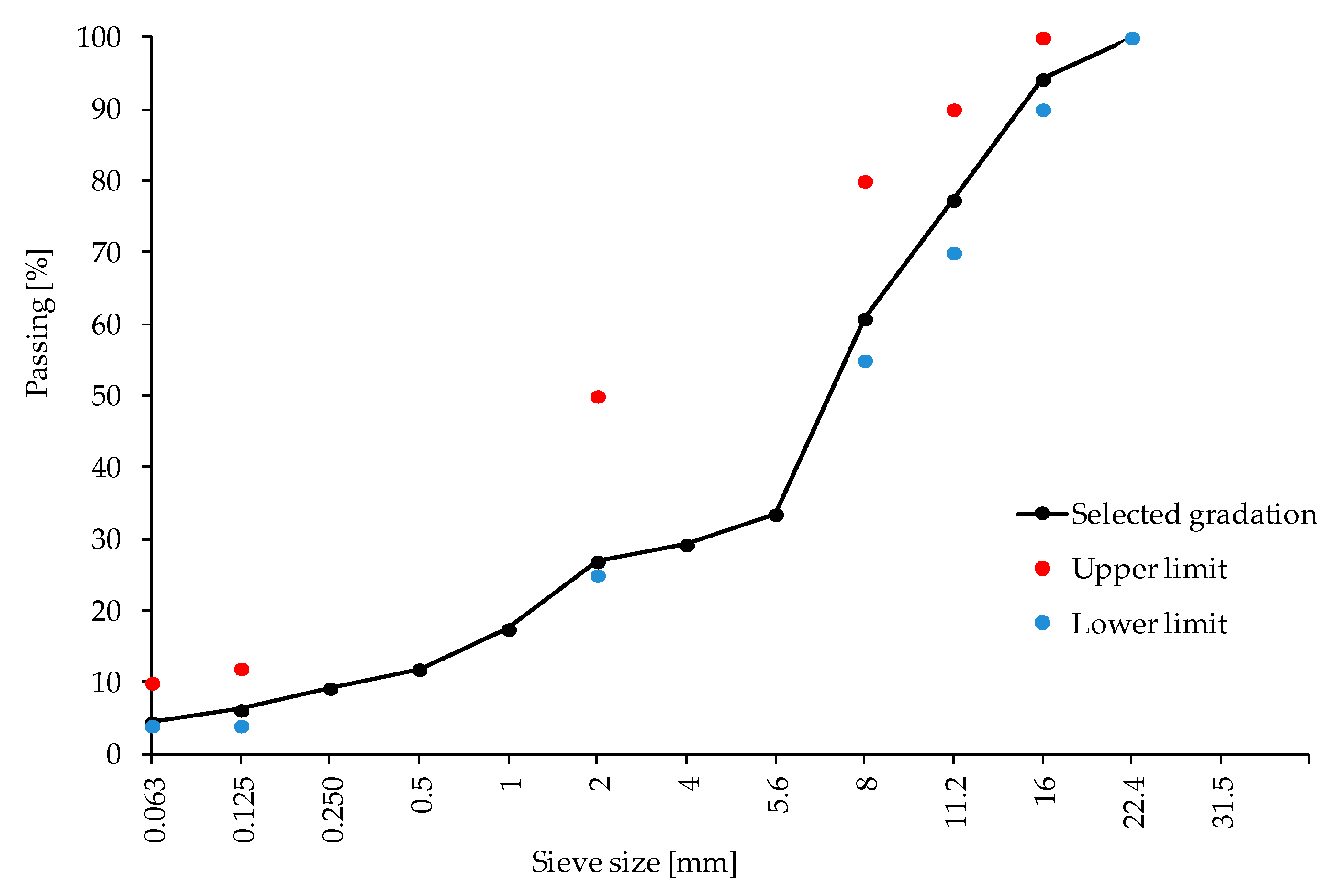


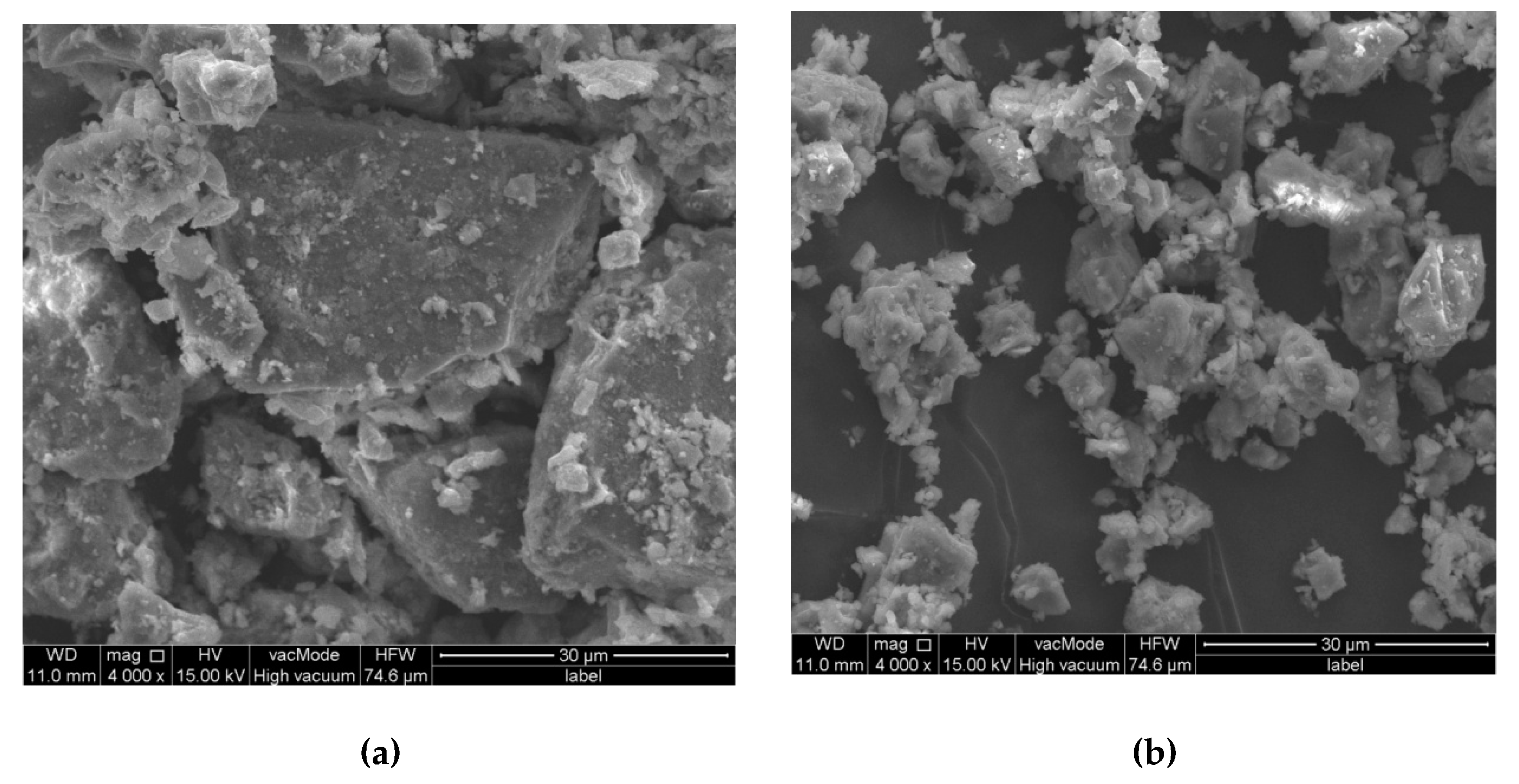
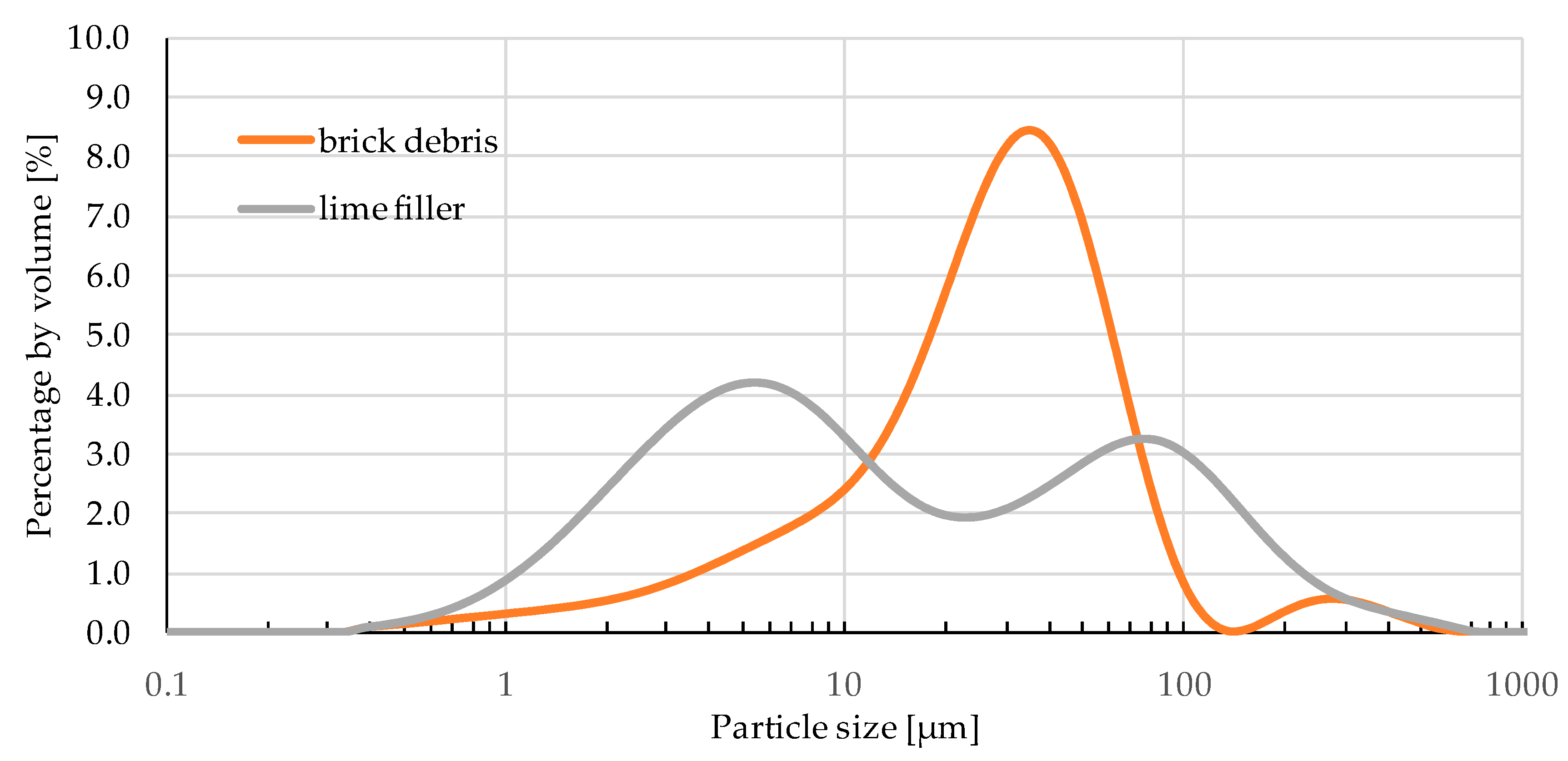
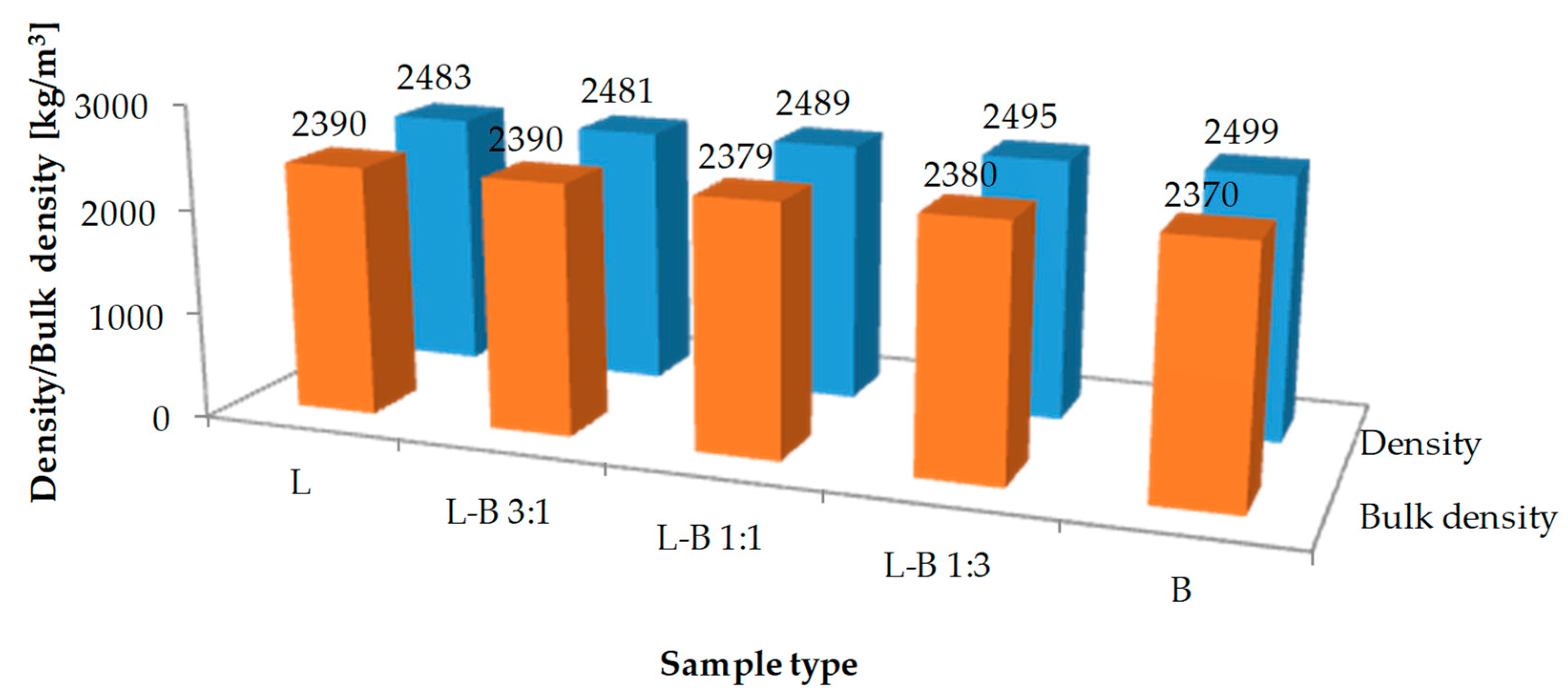
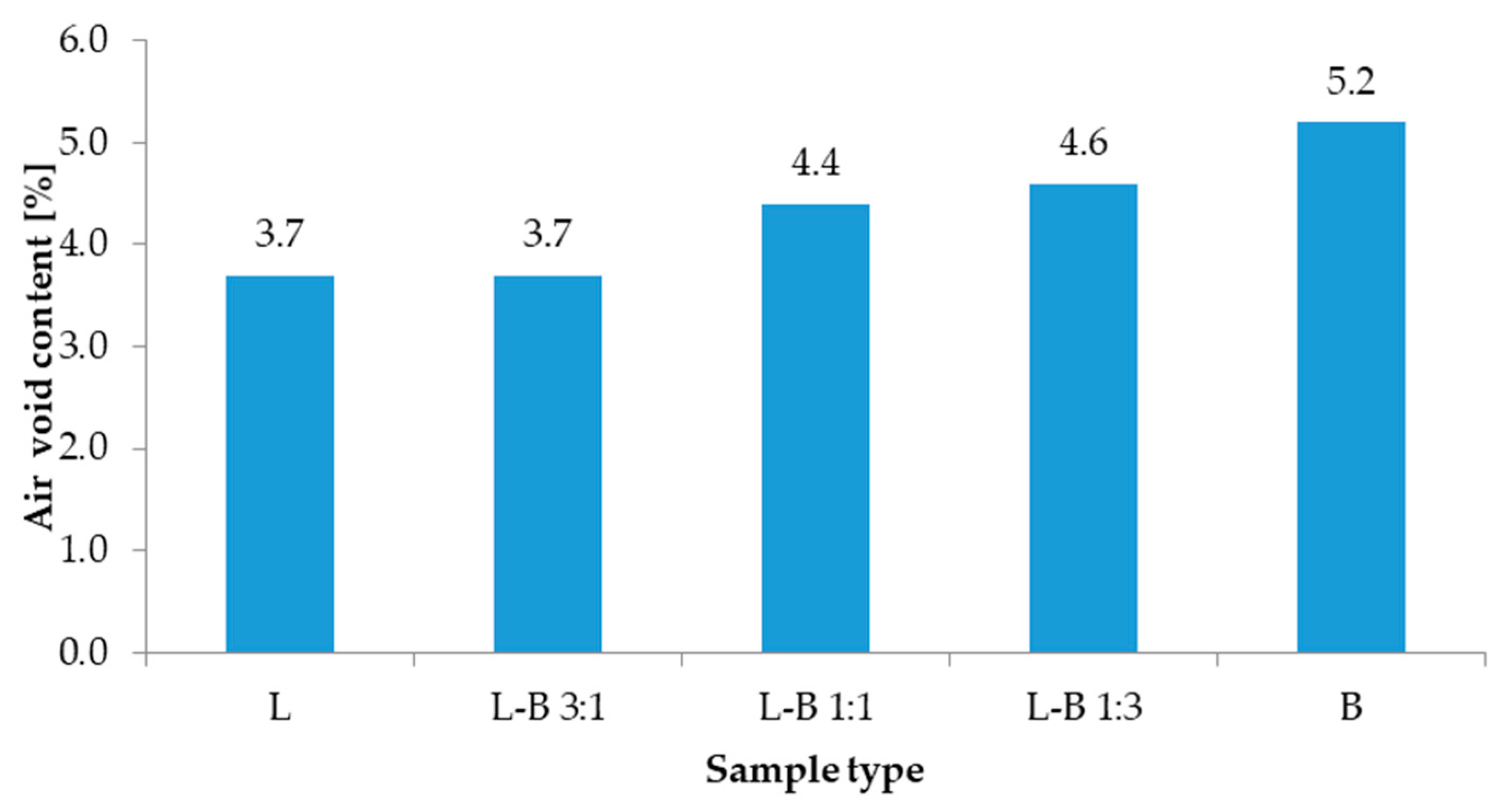
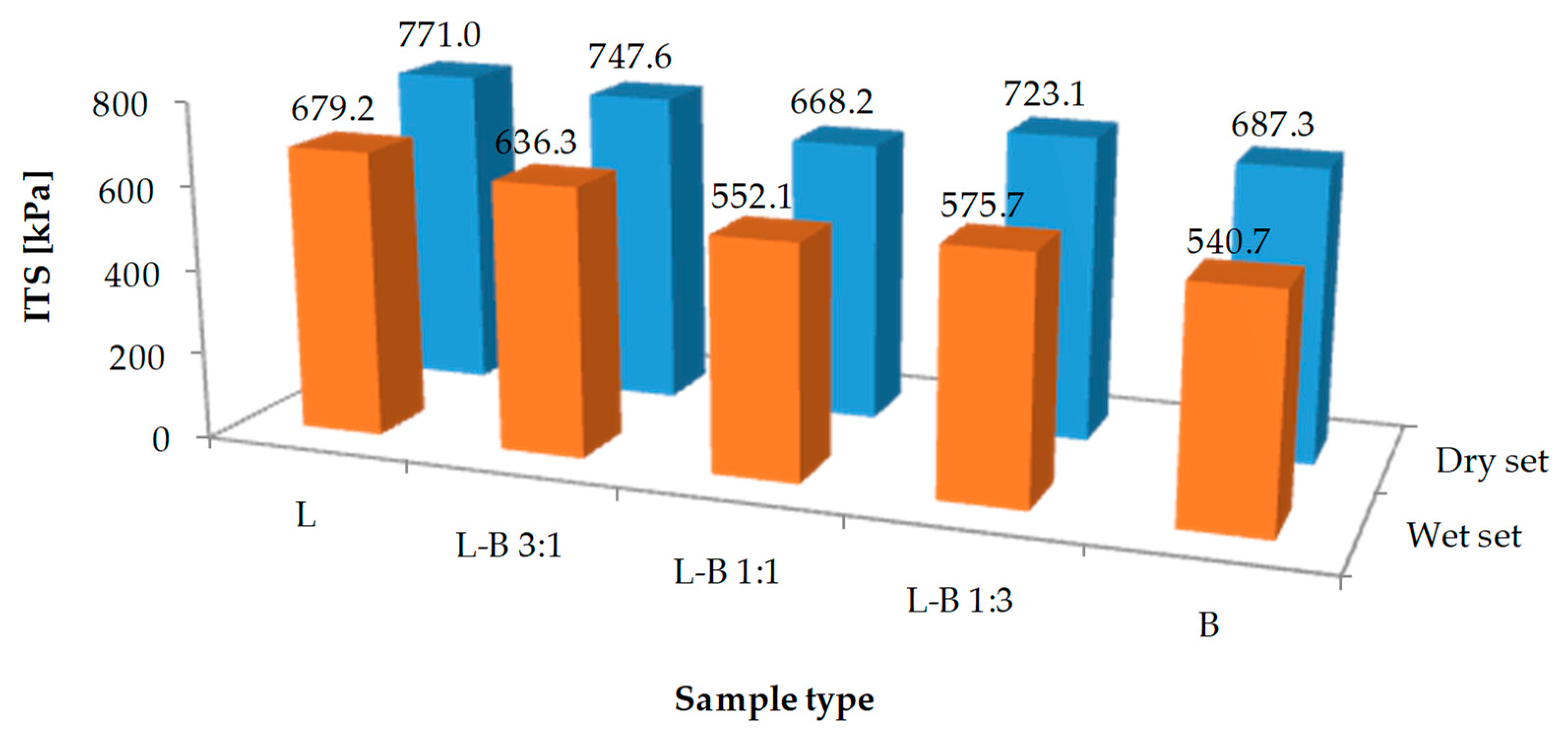
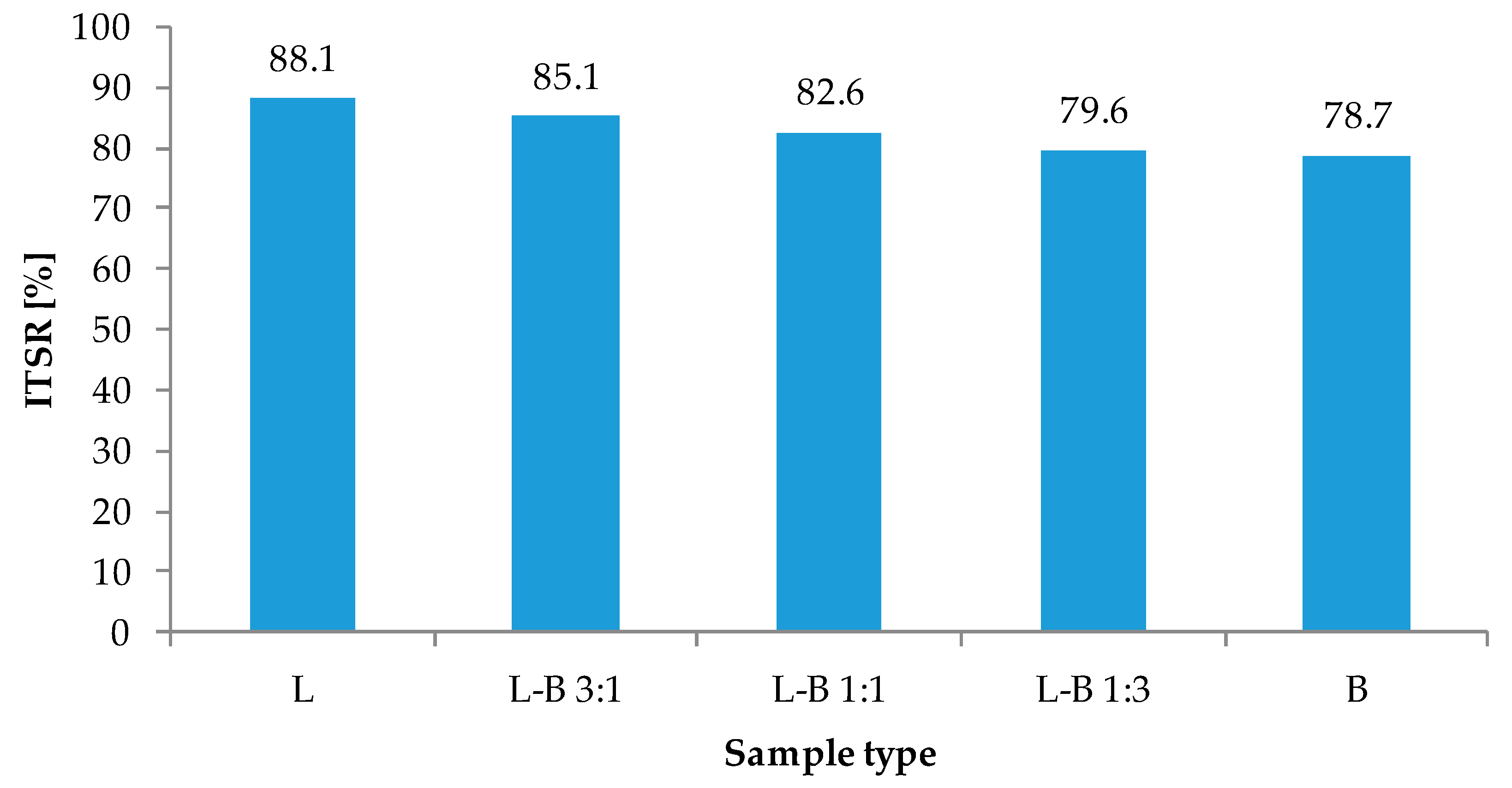
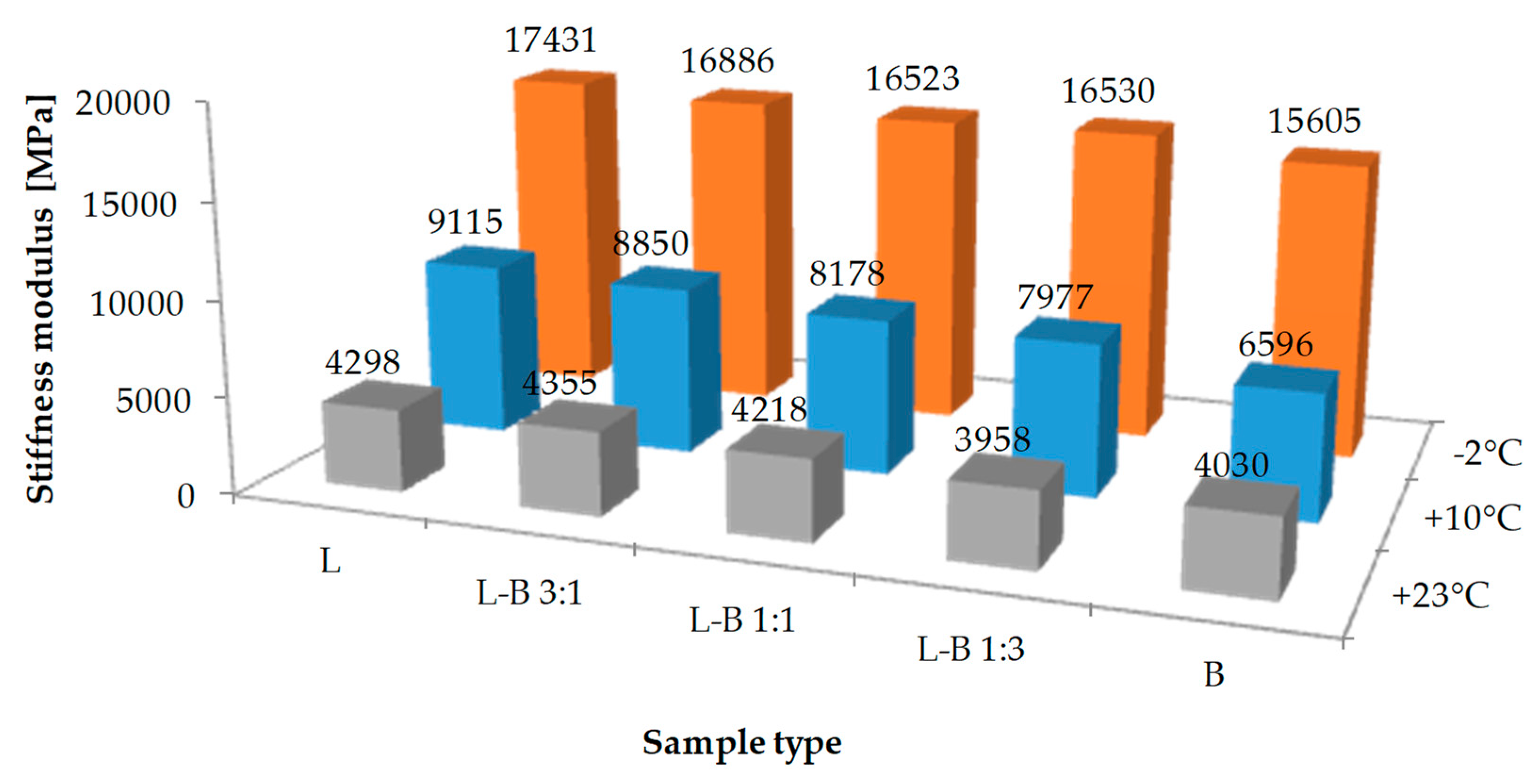
| Test | Specification | Result | |
|---|---|---|---|
| Lime Filler | Brick Debris Dust | ||
| Grain size [mm] | EN (European Standard) 933-10:2009 | 0–2 | 0–2 |
| Density [kg/m3] | EN 1097-7:2008 | 2763 | 2782 |
| Water content [%] | EN 1097-5:2008 | <1 | <1 |
| Test | Specification | Result | Specification Limits |
|---|---|---|---|
| Penetration (25 °C; 0.1 mm) | EN (European Standard) 1426:2009 | 38.2 | 35–50 |
| Softening point (°C) | EN 1427:2009 | 55.8 | 50–58 |
| Viscosity at 135 °C (Pa·s) | ASTM (American Society for Testing and Materials) D 4402 | 0.755 | - |
| Penetration index | EN 12591:2010 | −0.47 | - |
| Type of Aggregate | Grain Size [mm] | Origin | Composition [m%] | |
|---|---|---|---|---|
| Mineral Mixture | Asphalt Mix | |||
| Dolomite 0/4 | 0–4 | Łagów, Poland | 24.5 | 23.4 |
| Dolomite 2/8 | 2–8 | Łagów, Poland | 37 | 35.3 |
| Dolomite 8/16 | 8–16 | Łagów, Poland | 34 | 32.5 |
| Limestone filler | 0–2 | Bukowa mine, Poland | 4.5 | 4.3 |
| 35/50 asphalt | ORLEN Asfalt Sp. z o.o | 4.5 | ||
| Total | 100 | 100 | ||
| Brick Debris | Lime Filler | |
|---|---|---|
| [% of Weight] | ||
| MgO | 1.29 | 0.21 |
| Al2O3 | 9.68 | 0.15 |
| SiO2 | 76.19 | 0.27 |
| P2O5 | 0.00 | 0.02 |
| SO3 | 0.04 | 0.04 |
| K2O | 3.00 | 0.00 |
| CaO | 4.54 | 74.68 |
| TiO2 | 0.84 | 0.00 |
| Fe2O3 | 4.13 | 0.06 |
| Test Type | Origin | SS | df | MS | F | p | Test F |
|---|---|---|---|---|---|---|---|
| Density | Intergroups | 721 | 4 | 180 | 80 | 1.54 × 10−7 | 3.478 |
| Intragroups | 23 | 10 | 2 | ||||
| Bulk density | Intergroups | 837 | 4 | 209 | 18 | 1.34 × 10−4 | 3.478 |
| Intragroups | 114 | 10 | 11.4 | ||||
| Indirect tensile strength (wet) | Intergroups | 55,728 | 4 | 13,932 | 8.657 | 0.0008 | 3.056 |
| Intragroups | 24,140 | 15 | 1609 | ||||
| Indirect tensile strength (dry) | Intergroups | 28,469 | 4 | 7117 | 6.141 | 0.0039 | 3.056 |
| Intragroups | 17,385 | 15 | 1159 | ||||
| Stiffness modulus at 23 °C | Intergroups | 705,714 | 4 | 176,428 | 3.103 | 0.0333 | 2.759 |
| Intragroups | 1,421,308 | 25 | 56,852 | ||||
| Stiffness modulus at 10 °C | Intergroups | 23,202,499 | 4 | 5,800,625 | 17.806 | 4.94 × 10−7 | 2.759 |
| Intragroups | 8,144,274 | 25 | 325,771 | ||||
| Stiffness modulus at −2 °C | Intergroups | 10,638,660 | 4 | 2,659,665 | 4.344 | 0.0084 | 2.759 |
| Intragroups | 15,307,063 | 25 | 612,283 |
| Standard Deviation Values | |||||
|---|---|---|---|---|---|
| Test | L | L-B 3:1 | L-B 1:1 | L-B 1:3 | B |
| Density | 1.2 | 1.2 | 2.1 | 0.6 | 2.0 |
| Bulk density | 3.0 | 3.2 | 2.5 | 2.5 | 5.0 |
| ITSw | 42 | 60 | 34 | 18 | 34 |
| ITSd | 25 | 34 | 27 | 38 | 44 |
| Stiffness at 23 °C | 218 | 329 | 211 | 139 | 254 |
| Stiffness at 10 °C | 585 | 429 | 763 | 262 | 672 |
| Stiffness at −2 °C | 385 | 1072 | 1258 | 299 | 306 |
Publisher’s Note: MDPI stays neutral with regard to jurisdictional claims in published maps and institutional affiliations. |
© 2020 by the authors. Licensee MDPI, Basel, Switzerland. This article is an open access article distributed under the terms and conditions of the Creative Commons Attribution (CC BY) license (http://creativecommons.org/licenses/by/4.0/).
Share and Cite
Woszuk, A.; Wróbel, M.; Bandura, L.; Franus, W. Brick Debris Dust as an Ecological Filler and Its Effect on the Durability of Asphalt Mix. Materials 2020, 13, 5023. https://doi.org/10.3390/ma13215023
Woszuk A, Wróbel M, Bandura L, Franus W. Brick Debris Dust as an Ecological Filler and Its Effect on the Durability of Asphalt Mix. Materials. 2020; 13(21):5023. https://doi.org/10.3390/ma13215023
Chicago/Turabian StyleWoszuk, Agnieszka, Michał Wróbel, Lidia Bandura, and Wojciech Franus. 2020. "Brick Debris Dust as an Ecological Filler and Its Effect on the Durability of Asphalt Mix" Materials 13, no. 21: 5023. https://doi.org/10.3390/ma13215023






